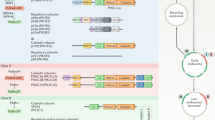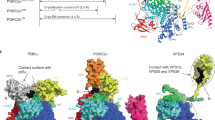Abstract
The generation of second messengers from the hydrolysis of phosphatidylinositol-4,5-bisphosphate (PtdInsP2) by phospho-inositidase C has been implicated in the mediation of cellular responses to a variety of growth factors and oncogene products1–4. The first step in the production of PtdInsP2 from phosphatidyl-inositol (PtdIns) is catalysed by PtdIns kinase. A PtdIns kinase activity has been found to associate specifically with several oncogene products, as well as with the platelet-derived growth factor (PDGF) receptor5–8. We have previously identified two biochemically distinct PtdIns kinases in fibroblasts, and have found that only one of these, designated type I, specifically associates with activated tyrosine kinases7. We have now characterized the site on the inositol ring phosphorylated by type I PtdIns kinase, and find that this kinase specifically phosphorylates the D-3 ring position to generate a novel phospholipid, phosphatidylinositol-3-phosphate (PtdIns(3)P). In contrast, the main PtdIns kinase in fibroblasts, designated type II, specifically phosphorylates the D-4 position to produce phosphatidylinositol-4-phosphate (PtdIns(4)P), previously considered to be the only form of PtdInsP (ref. 9). We have also tentatively identified PtdIns(3)P as a minor component of total PtdInsP in intact fibroblasts. We propose that type I Ptdlns kinase is responsible for the generation of PtdIns(3)P in intact cells, and that this novel phosphoinositide could be important in the transduction of mitogenic and oncogenic signals.
This is a preview of subscription content, access via your institution
Access options
Subscribe to this journal
Receive 51 print issues and online access
$199.00 per year
only $3.90 per issue
Buy this article
- Purchase on Springer Link
- Instant access to full article PDF
Prices may be subject to local taxes which are calculated during checkout
Similar content being viewed by others
References
Whitman, M., Fleischman, L., Chahwala, S. B., Cantley, L. & Rosoff, P. in Pl Turnover and Receptor Function (ed. Putney, J.) 197–217 (Liss, New York, 1986).
Berridge, M. Biochim. biophys. Acta 907, 33–45 (1987).
Downes, C. P. & Michell, R. H. in Molecular Aspects of Cellular Regulation Vol. 4 (eds Cohen, P. & Houslay, M. D.) 3–56 (Elsevier, Amsterdam, 1985).
Macara, I. G. Am. J. Physiol. 248, C3–C11 (1985).
Whitman, M., Kaplan, D. R., Schaffhausen, B. S., Cantley, L. & Roberts, T. Nature 315, 239–242 (1985).
Kaplan, D. R. et al. Proc. natn. Acad. Sci. U.S.A. 83, 3,624–3,628 (1986).
Whitman, M., Kaplan, D. R., Roberts, T. M. & Cantley, L. C. Biochem. J. 247, 165–174 (1987).
Kaplan, D. R. et al. Cell 50, 1021–1029 (1987).
Chang, M. & Ballou, C. E. Biochem. biophys. Res. Commun. 26, 199–205 (1967).
Brown, D. M. & Stewart, J. C. Biochem. biophys. Acta 125, 413–421 (1966).
Grado, C. & Ballou, C. E. J. biol. Chem. 236, 54–60 (1961).
Irvine, R. F., Letcher, A. J., Lander, D. J. & Downes, C. P. Biochem. J. 223, 237–243 (1984).
Prottey, C. Salway, J. G. & Hawthorne, J. N. Biochim. biophys. Acta 164, 238–251 (1968).
Endemann, G., Dunn, S. & Cantley, L. Biochemistry 26, 6845–6851 (1987).
Hawkins, P. T., Stephens, L. & Downes, C. P. Biochem. J. 238, 507–516 (1986).
Harden, T. K., Stephens, L., Hawkins, P. T. & Downes, C. P. J. biol. Chem. 262, 9059–9061 (1987).
Hers, L. & Hue, S. A. Rev. Biochem. 52, 617–654 (1983).
Hawkins, P. T., Stephens, L. & Downes, C. P. Biochem. J. 238, 507–516 (1986).
Stephens, L. R. et al. Biochem. J. (in the press).
Author information
Authors and Affiliations
Rights and permissions
About this article
Cite this article
Whitman, M., Downes, C., Keeler, M. et al. Type I phosphatidylinositol kinase makes a novel inositol phospholipid, phosphatidylinositol-3-phosphate. Nature 332, 644–646 (1988). https://doi.org/10.1038/332644a0
Received:
Accepted:
Issue Date:
DOI: https://doi.org/10.1038/332644a0
This article is cited by
-
Antitumor activity of the PI3K δ-sparing inhibitor MEN1611 in PIK3CA mutated, trastuzumab-resistant HER2 + breast cancer
Breast Cancer Research and Treatment (2023)
-
At a crossroads: how to translate the roles of PI3K in oncogenic and metabolic signalling into improvements in cancer therapy
Nature Reviews Clinical Oncology (2022)
-
Targeting the PI3K Pathway in Gynecologic Malignancies
Current Oncology Reports (2022)
-
PRMT5-mediated arginine methylation activates AKT kinase to govern tumorigenesis
Nature Communications (2021)
-
The effect of Ganoderma lucidum extract on immunological function and identify its anti-tumor immunostimulatory activity based on the biological network
Scientific Reports (2018)
Comments
By submitting a comment you agree to abide by our Terms and Community Guidelines. If you find something abusive or that does not comply with our terms or guidelines please flag it as inappropriate.



